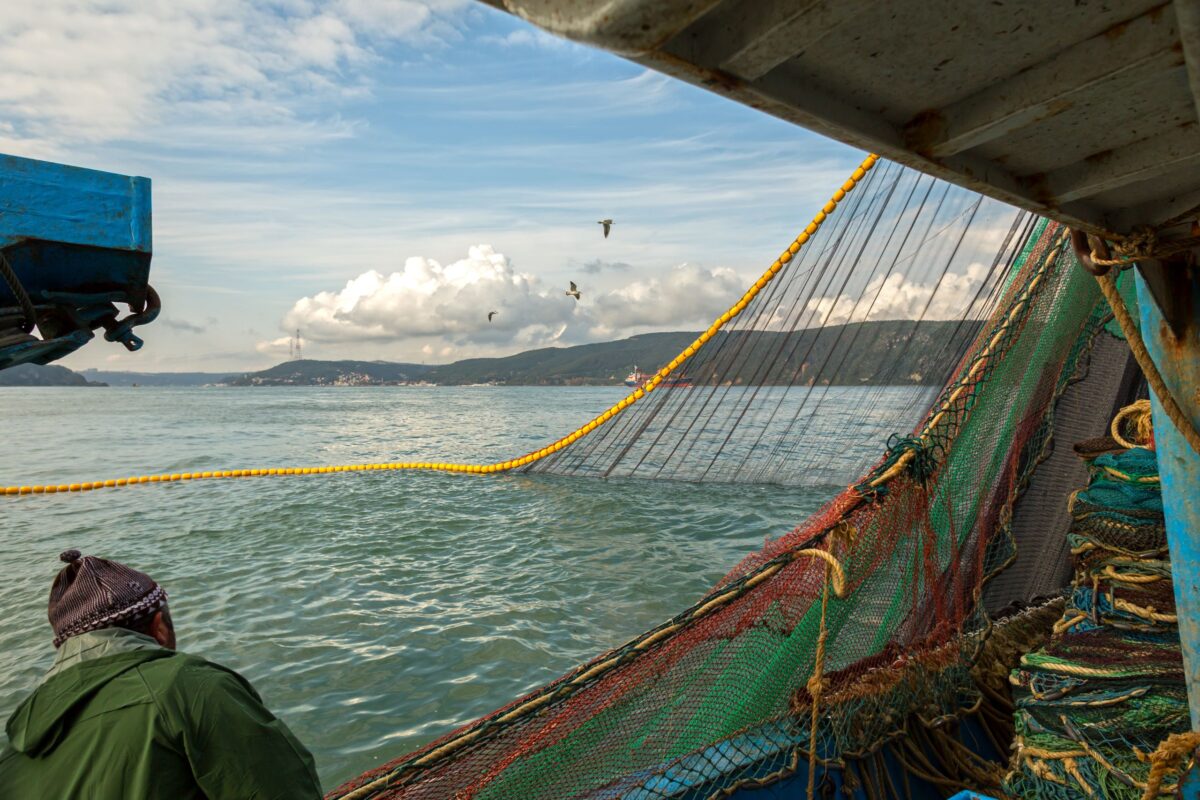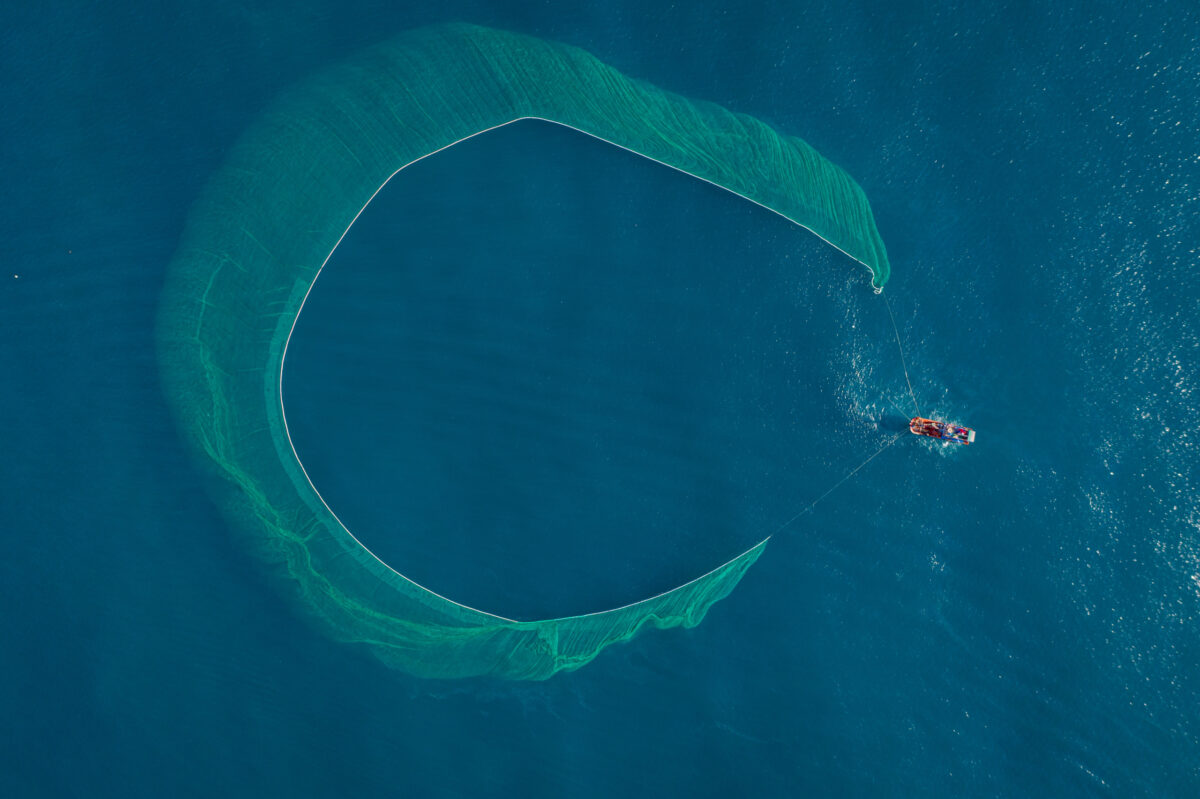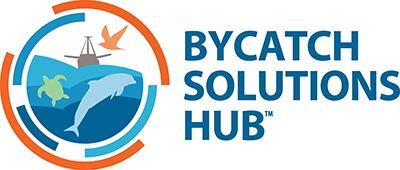Gear Types
Purse Seines
Purse seines are common in both small-scale and industrial fisheries, used to target schooling pelagic fishes such as tunas, anchovies, and sardines.
Purse seines are large nets that are used to encircle large schools of fish before the bottom of the net is closed (pursed). Once the net is pursed, fish cannot escape through the bottom of the large net, and the net walls are pulled in. However, this process also catches a lot of other animals swimming with the schools of target fish. Historically, bycatch mortality rates in purse seine fisheries were high, but through the use of updated practices and gears bycatch mortality rates can be effectively reduced.
How do purse seines find schools of fish in the open ocean?
There are two main classifications for purse seine fisheries, those that set nets around fish aggregating devices (FAD-associated) and those that do not (free-swimming). Finding a school of target fish is the most difficult part of purse seine fishing, and therefore many tools and techniques have been developed to find fish. Over the last two decades, fishers have deployed trackable FADs, which are designed to attract schooling fish. Nets are then set around the FADs, but bycatch can still be high since many other animals are also attracted to FADs.
When the purse seine is closed, vessels can use the “backdown method”, which opens a section of the net on the surface where dolphins, porpoises, and sea turtles can escape.

Purse seine set from vessel.

A purse seine is set.
One way to target fish was to set nets around pods of dolphins and porpoises or whale sharks because they often school with tuna. This practice led to disturbingly high bycatch mortality rates and should be avoided at all times (though it is still legal in many areas).
FADs are more commonly used now. However, FADs are typically made of plastic (poly ropes and nets) and include hanging structures that can entangle wildlife. If lost or abandoned, these non-biodegradable FADs will continue to entangle wildlife as they drift with currents, potentially for years. Fortunately, new techniques and gear configurations have been shown to greatly reduce the ETP bycatch impacts of both FAD-associated and free-swimming sets.
ETP Impacts and Fishery Recommendations
- Prohibit setting nets around marine mammals and whale sharks.
- Use best practices when marine mammals are encircled in the net to allow escape before hauling onto the deck, for example the backdown method and Medina panel.
- Require trackers on deployed FADs, to provide accurate and reliable geolocation and identification information.
- Require the use of non-entanglement and biodegradable FADs.
- Require 100% coverage on all fishing vessels – through a combination of human observer and electronic monitoring – with detailed bycatch data collection.
- Ensure 100% compliance with all management measures specific to marine mammals, both at the country and management-organization level.
- Require the use of non-entangling and biodegradable FADs.
- Provide best methods handling-and-release training to the captain and crew.
- Require 100% coverage on all fishing vessels – through a combination of human observer and electronic monitoring – with detailed bycatch data collection.
- Ensure 100% compliance with all management measures specific to sea turtles, both at the country and management-organization level.
- Provide best methods handling-and-release training to the captain and crew.
- Require 100% coverage on all fishing vessels – through a combination of human observer and electronic monitoring – with detailed bycatch data collection.
- Ensure 100% compliance with all management measures specific to seabirds, both at the country and management-organization level.
- Prohibit setting nets around whale sharks and pelagic rays.
- Require the use of non-entangling, biodegradable FADs.
- Release sharks encircled in the net before hauling onto the deck.
- Provide best methods handling-and-release training to the captain and crew.
- Require trackers on deployed FADs, to provide accurate and reliable geolocation and identification information.
- Require 100% coverage on all fishing vessels – through a combination of human observer and electronic monitoring – with detailed bycatch data collection.
- Ensure 100% compliance with all management measures specific to sharks and rays, both at the country and management-organization level.
Purse seines are sometimes set around pods of dolphins and porpoise in order to catch tuna. In the past, this practice led to very high bycatch mortality. Even when attempts are made to release encircled dolphins and porpoises, the large number of stressed-out animals can lead to entanglement in the net. Therefore, the dolphin-set method should be eliminated from the fishery, and tuna caught from dolphin sets should never be included in a company’s seafood sourcing. Before the seine is pulled tight, the backdown method can create an opening in the net where dolphins and porpoises can be herded out by divers. This is effective for those occasionally caught and can essentially eliminate marine mammal bycatch in purse seines when interactions are limited to a few individuals during a haul.
General Recommendations
Sea turtles in the open ocean can be unintentionally encircled by the purse seine, especially for FAD-associated sets. Proper handling-and-release training can greatly reduce the stress and potential injuries for encircled sea turtles, and the turtles can mostly be released in good health. Sea turtles are also vulnerable to entanglement and drowning in the FAD material itself, as they are attracted to the FAD structure for both shelter and food. Entanglement risk can be mitigated through the use of non-entangling FADs.
General Recommendations
Seabirds are vulnerable to entanglement in the net during hauling. They will dive into the pursed net to prey on small fish and can get caught in excess net floating on the surface, trapping them underwater. New developments of modified purse seines that remove excess net and redesign the buoy attachments to the float line greatly reduce the entanglement risk to seabirds. These modified purse seines are critical in areas that overlap with vulnerable and endangered seabird species, particularly albatrosses and petrels.
General Recommendations
Purse seines are sometimes set around whale sharks and schools of pelagic rays since they often indicate schools of tuna below. This led to high bycatch mortality rates and the practice should be prohibited. Other species of sharks and rays also school with tunas and around FADs and can therefore be caught in high numbers in purse seines. Unlike small cetaceans and sea turtles, sharks dive to the bottom of the net when it is closing. This makes it much more unlikely that they can escape during the backdown, so they either need to be released through an opening at the bottom of the net or after being landed. Sharks and rays can also get entangled in traditional FADs, a risk that can be eliminated through the deployment of non-entangling FADs.
General Recommendations
